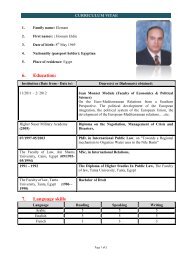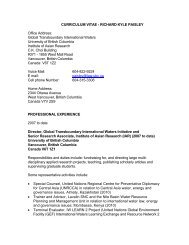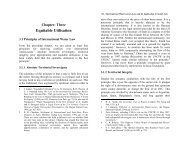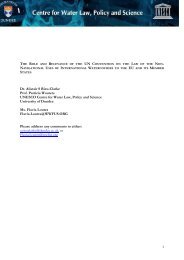Upreti, Trilochan, International Watercourses Law and Its Application ...
Upreti, Trilochan, International Watercourses Law and Its Application ...
Upreti, Trilochan, International Watercourses Law and Its Application ...
Create successful ePaper yourself
Turn your PDF publications into a flip-book with our unique Google optimized e-Paper software.
254 / <strong>International</strong> <strong>Watercourses</strong> <strong>Law</strong> <strong>and</strong> <strong>Its</strong> <strong>Application</strong> in South Asia Prospects <strong>and</strong> Problems of Nepalese Water Resources / 255outst<strong>and</strong>ing problems existing between them, including theissue of augmenting dry season flow in the Ganga by divertingthe Brahamaputra through the Arun valley via Tibetan territory,which can be achieved with Nepal’s co-operation. 212A suitable model, particularly in the Indo-Nepalese sphere, isthe Columbia River Treaty arrangement between the USA <strong>and</strong>Canada, which is suggested as the ideal point of reference.Those benefits were shared, <strong>and</strong> the cost of the reservoir <strong>and</strong>dam construction, along with the submergence, displacement<strong>and</strong> rehabilitation cost, was paid by the United States. 213 It isargued that such co-operation can prevent confrontation, <strong>and</strong>that the best way of resolving international water disputes is bynegotiation, <strong>and</strong> concluding agreements; even submitting adispute in a court or tribunal is not proven to be the best way. 214However, numerous instances have illustrated how theinvolvement of heads of state <strong>and</strong> governments has enabled theavoidance of conflicts <strong>and</strong> facilitated agreement in manycomplex <strong>and</strong> chronic issues between a weaker <strong>and</strong> a morepowerful state. President Echeverria of Mexico <strong>and</strong> PresidentNixon of the USA resolved the salinity problem on theColorado River, which was seen as most delicate problembetween the two countries, <strong>and</strong> it was politically difficult forthe USA to construct such a huge project at her own cost. 215212 Supra note 174. See H. L. Shrestha, “SAARC, China <strong>and</strong> Pan-AsianUnity” in U. Gautam (ed), South Asia <strong>and</strong> China: Towards Inter-Regional Cooperation, Kathm<strong>and</strong>u: China Study Centre, (2003), p. 59.213 L. Teclaff, “Harmonizing Water Use <strong>and</strong> Development WithEnvironmental Protection” in A. Utton & L. Teclaff (eds), Water in theDeveloping World: The Management of a Critical Resources,Colorado: Westview Press, 1978, pp. 104-105.214 B. R. Chauhan, Settlement of <strong>International</strong> Water <strong>Law</strong> Disputes in<strong>International</strong> Drainage Basins, Berlin: Eric Schmidt Verlag, 1981, p.463.215 Supra note 210, p. 160.The current Indian Prime Minister, A. B. Bajpayee, is nowdirectly involved in ending the bitter relations of the pastbetween his country <strong>and</strong> Pakistan, replacing them with a goodneighbourly relationship. A similar, dynamic approach needs tobe adopted in the case of Nepal.According to the current energy trends, India has enough fossilfuel reserves for forty years, Bangladesh for thirty years <strong>and</strong>Pakistan for about twenty years. After these periods haveelapsed, each country will be compelled to turn to waterresources. 216 The co-operation between Bhutan <strong>and</strong> India showsthat both states are accruing tremendous benefits; the sameapproach is proving successful in the Mekong Basin, in whichThail<strong>and</strong> guaranteed a loan on behalf of Laos from the worldcapital market, <strong>and</strong> provided some amount in advance for thepurchase of the hydropower which is being developed. Laos iscommissioning these projects purely for export purposes, forwhich a regional grid has been already constructed to deliverthe hydropower to Thail<strong>and</strong>. This regional grid was constructedby the Mekong Commission, with the money being provided bythe WB <strong>and</strong> the UNDP. 217 There are other similar models: suchas Itaipu (Paraguay <strong>and</strong> Brazil) <strong>and</strong> Yacerata (Paraguay <strong>and</strong>Argentina). In both examples, the money was borrowed fromthe world market (the WB <strong>and</strong> the Latin American Bank), forwhich Brazil <strong>and</strong> Argentina have provided a sovereign guarantyfor Paraguay. Moreover, each project started with a capitalinvestment of US$ 100 million, for which each country lentParaguay its share of the initial capital of US$ 50 million under216 R. D. Joshi, "Nepali Hydropower <strong>and</strong> Regional Energy Needs” (1994)in 4 Water Nepal, p. 156.217 P. Chomchai, “Management of Tranboundary Water Resources: ACase Study of the Mekong” in M. I. (ed), The United Nations at Work,Westport, CT: Praeger, 1998, pp. 254-255.












